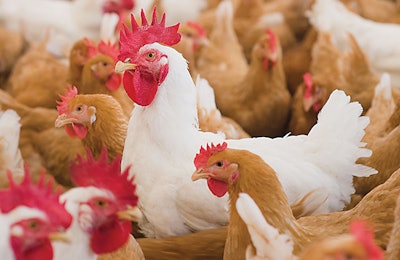
Consumers do not presently know much about the differences between conventional chicken breeds and slower-growing breeds, and as a result, their opinions can be swayed pretty easily, according to a recent study.
Dr. Jayson Lusk, professor and department head at Purdue University's department of agricultural economics, presented the results of the study, “Consumer beliefs, knowledge and willingness-to-pay for sustainability-related poultry production practices,” while speaking at the 2018 Animal Agriculture Alliance Stakeholders Summit on May 3 in Arlington, Virginia. The study was funded by the alliance, the Food Marketing Institute Foundation and the Foundation for Food and Agriculture Research.

Dr. Jayson Lusk said consumers buying decisions depend heavily on the information they consume. | Photo by Roy Graber
About the study
The study surveyed about 2,000 people and sought opinions on slower-growing chickens. Animal rights groups continue to pressure retailers to sign agreements to source only chicken products from slower-growing broilers. The survey respondents were asked if they would be willing to pay more for the product presented as better for animal welfare.
Some respondents were given no information on which to base their responses, others were given National Public Radio and New York Times reports showing a bias toward slower-growing chickens, while others were given information produced by the National Chicken Council (NCC) showing the negative effects of an industry switch to slower-growing breeds.
Information influences opinions
Of those presented with no information, a little more than 70 percent said they would be willing to pay a premium of 40 cents to $1 per pound for a product from slower-growing broilers, while roughly 30 percent said they would not be willing to pay a premium that exceeded 39 cents. None stated they would pay more than $1 premium.
Those presented with information favoring slow-growth chicken said they would be willing to pay extra. About 55 percent said they would pay a premium ranging from 40 cents to $1, and 45 percent said they would be willing to pay a premium of more than $1.
Those shown the NCC information had a common response. None of those surveyed said they would be willing to pay a premium of 40 cents or more.
“What does this tell me? It tells me people don’t really have any idea what this label means. So I can push them this way, or I can push them that way,” Lusk said. "They don’t know much about it. It’s something they haven’t thought much about."
The survey also demonstrated limited interest in slower-growing broilers as only about 16 percent of the respondents believed chicken breasts are currently too large.
Lusk said the survey revealed to him that, at the baseline, most people don’t necessarily see the benefits of paying more for slow-growth chicken.
“It would actually take some pushing,” Lusk said. “Somebody wanting to market this would actually have to make a case for why people would want it.”
He added that often, while people are taking part in surveys, they will say they have a willingness to pay more for a poultry product raised under certain conditions, but when it comes time to actually spend money at the grocery store, they opt for the product with the lowest price.
Consumer knowledge of broiler production
Lusk spoke of a lack of knowledge of slower-growing broilers, but the survey also showed a lack of understanding of the poultry industry as a whole.
No broiler chickens are raised in cages in the United States, but only 2.5 percent of respondents knew that was true. Also, only 11 percent of respondents knew that broiler chickens were not given added growth hormones.
“People’s beliefs are very far out of line with the reality of broiler production,” Lusk said.
Retailers and the push to switch to slow-growth chicken
The biggest advocates for the switch away from conventional broiler breeds and toward slower-growing breeds are the animal rights groups, which Lusk says have actively met with retailers in an effort to get them to make that change.
To date, the majority of those agreeing to switch are foodservice companies and restaurant chains – some with a very small volume of chicken sales. But Whole Foods Market is the only grocery chain to pledge to switch.
While the other grocery chains hold out, Lusk hopes they can see the results of the study so they can make an informed decision on consumer attitudes about the issue, rather than agree to a pledge due to pressure from groups with a specific agenda that doesn’t necessarily reflect consumer desires.
“At least there’s some data now that they can use to get a sense on what the market may look like,” said Lusk.

















